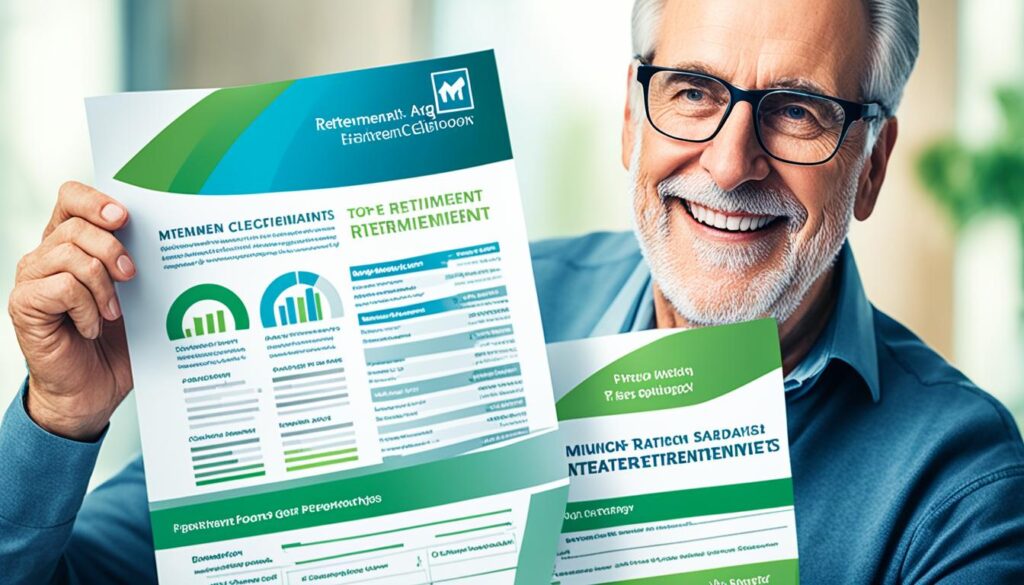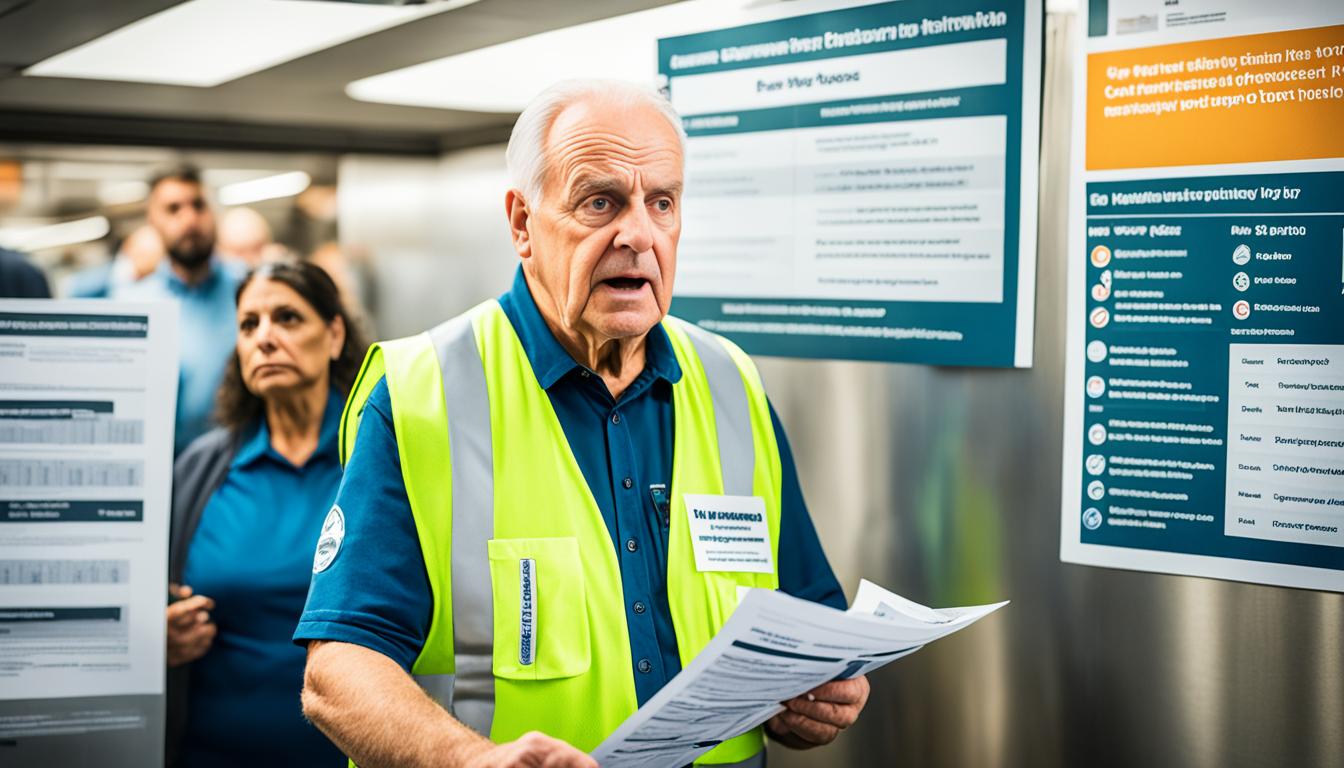MTA Retirement Age: Understanding Pension and Eligibility
Did you know that the average tenure at the MTA is 10.4 years, which is nearly 3 times longer than the national private sector average? This impressive statistic highlights the stability and rewarding nature of a career within the Metropolitan Transportation Authority. As an MTA employee, you not only contribute to a vital public service but also enjoy excellent retirement benefits that provide financial security and peace of mind in your retirement years.
The MTA understands the importance of taking care of its employees and offers a comprehensive range of retirement benefits. From pension plans and healthcare coverage to generous paid time off and leave benefits, the MTA is committed to supporting its employees throughout their careers and into retirement.
Key Takeaways:
- The MTA offers great benefits for its employees, including retirement plans.
- The average tenure at the MTA is 10.4 years, nearly 3 times longer than the national private sector average.
- MTA employee contributions towards healthcare coverage are more affordable compared to those in large private companies.
- MTA offers excellent individual, family, and domestic partnership health care coverage under the New York State Health Insurance Program (NYSHIP).
- The MTA provides low employee contributions towards monthly premiums for high-quality health plans and competitive out-of-pocket costs for prescriptions.
MTA Retirement Plan Options
The Metropolitan Transportation Authority (MTA) offers an exceptional retirement benefit package to its employees. One of the main options is the traditional defined benefit pension plan which guarantees a percentage of the employee’s final average salary for life. This means that employees can enjoy a stable income in their retirement years.
Unlike many large private companies where access to a traditional pension is becoming increasingly rare, the MTA recognizes the importance of providing this valuable benefit to its employees. In fact, only an estimated 18% of new hires in large private companies currently have access to a traditional pension.
Additionally, the MTA offers supplemental tax-advantaged deferred compensation retirement savings plans such as 401(k) and 457 plans. These plans provide immediate eligibility and allow employees to contribute to both simultaneously. While the MTA does not match employee contributions to these plans, they still offer a valuable opportunity for employees to save for their retirement.
Having access to both a traditional pension and supplemental retirement savings plans gives MTA employees the flexibility to build a secure and comfortable retirement. Employees can use retirement planning tools such as the MTA pension calculator to estimate their future pension benefits and determine the most effective retirement strategy.
By offering these retirement plan options, the MTA demonstrates its commitment to helping employees prepare for a financially stable future. Whether an employee chooses to rely primarily on the traditional pension plan or take advantage of the additional savings plans, the MTA retirement benefits provide a solid foundation for retirement security and peace of mind.
MTA Health Care Benefits in Retirement
In retirement, MTA employees can enjoy lifetime health care coverage for themselves and their eligible dependents. This benefit does not require retiree contributions towards premiums, providing essential support for retiree’s quality of life and peace of mind. Unlike many large private firms that no longer provide health benefits to retirees, the MTA recognizes the importance of maintaining access to health care during retirement.
Retirees can rely on the MTA’s comprehensive health care coverage to help protect against illness and disability. This coverage extends to both the retiree and their eligible dependents, ensuring that their healthcare needs are taken care of throughout their retirement years.
Additionally, the MTA provides transportation passes in retirement, allowing retired employees to continue using New York City’s public transportation system. This benefit not only helps retirees stay connected with the city they served for many years but also provides a convenient and cost-effective mode of transportation.
These health care benefits in retirement, along with the transportation pass, are part of the comprehensive package that the MTA offers to its employees. By providing exceptional support for retirees’ quality of life and addressing their healthcare needs, the MTA demonstrates its commitment to the well-being of its workforce even after they have transitioned into retirement.
Eligibility and Vesting Requirements
When it comes to retirement benefits at the MTA, there are certain eligibility and vesting requirements to consider. These requirements determine when you can start receiving your pension benefits, retiree health care, and transportation pass benefits.
To be eligible for full pension benefits, you generally need to have completed 5 years of service with the MTA and reach the age of 62. It’s important to note that these eligibility criteria are based on a $100,000 final average salary.
In order to qualify for retiree health care, you must have been a member of the MTA pension plan for at least 10 years and be able to immediately collect your pension benefits. This ensures that you have access to comprehensive health care coverage in your retirement years.
If you’re interested in transportation pass benefits during retirement, you’ll need to have completed 10 years of service with the MTA. This allows you to continue using the city’s public transportation system at no additional cost, helping you stay connected and mobile.
It’s important to keep in mind that the MTA’s benefits are subject to change at any time. Additionally, some benefit programs may be administered and interpreted outside of the MTA. Therefore, it’s crucial to stay informed about any updates or changes that may affect your retirement benefits.
Overall, understanding the eligibility and vesting requirements is essential for maximizing your retirement benefits at the MTA. By meeting these requirements, you can ensure that you’re able to take full advantage of the pension, health care, and transportation benefits available to you.
Paid Time Off and Leave Benefits
In addition to the valuable retirement benefits provided by the MTA, employees also enjoy a range of generous paid time off and leave benefits. These benefits are designed to ensure that transit workers can maintain a healthy work-life balance and take the time they need to recharge and care for their personal needs.
One of the key benefits is paid vacation days, which increase with years of service. As employees accumulate more years at the MTA, they earn additional vacation days, allowing them to take longer breaks and enjoy well-deserved time away.
After four years of service, employees are also entitled to paid personal days. These personal days can be used for various purposes, whether it’s attending appointments, attending to personal matters, or simply taking a day off to relax and unwind.
The MTA also ensures that employees have paid holidays, allowing them to spend important days like Thanksgiving, Christmas, and New Year’s with their loved ones. The MTA recognizes the importance of these special occasions and ensures that employees have the time to celebrate and enjoy quality time with their families.
Furthermore, the MTA provides paid sick days to its employees. Sick days can be carried over from year to year with no limit if unused, providing an essential safety net for unforeseen health issues. Additionally, upon retirement or separation, employees can receive partial compensation for any unused sick days, providing an additional financial benefit during this important transition in their lives.
Recognizing that health issues can also arise outside of work, the MTA offers short-term disability insurance. This insurance ensures that employees receive 100% of their pay for up to 26 weeks if they are unable to work due to a qualifying non-work-related disability. This coverage provides peace of mind and financial stability during these challenging times.
In addition to short-term disability insurance, the MTA also offers long-term disability insurance. This coverage provides employees with 60% of their pay after 26 weeks of disability, ensuring ongoing financial support and security in the event of a long-term health condition.
Overall, the MTA understands the importance of providing ample paid time off and leave benefits to its employees. These benefits not only support the well-being and work-life balance of transit workers but also contribute to a positive and fulfilling work experience.
Employee Testimonials
I have had the privilege of working at the MTA, and I can attest to the numerous benefits and rewards that come with a career in this organization. The stability and job security provided by the MTA are invaluable, especially in today’s unpredictable job market. Knowing that I am part of an organization that values its employees and offers generous retirement benefits gives me peace of mind for the future.
“The retirement benefits at the MTA are exceptional. I feel confident that my future is secure, and I won’t have to worry about financial struggles in my retirement years.” – Sarah, MTA Employee
One aspect that sets the MTA apart is the opportunity to make a meaningful impact in serving the public. As an employee, I take pride in knowing that my work contributes to the functioning of New York City’s transportation system and helps millions of people reach their destinations safely and efficiently. It’s fulfilling to be part of such an essential service.
Another highlight of working at the MTA is the growth opportunities and diverse projects available. From collaborating on major infrastructure projects to developing innovative solutions for transit challenges, every day presents new and exciting challenges. This continuous learning and professional development contribute to a fulfilling and rewarding career at the MTA.
“I’ve had the opportunity to work on various projects during my time at the MTA, expanding my skills and knowledge. It’s an enriching experience that keeps me motivated and engaged.” – Michael, MTA Employee
Overall, the testimonials of MTA employees speak volumes about the positive experiences and benefits they have enjoyed throughout their careers. The stability, job security, retirement benefits, and growth opportunities provided by the MTA make it an appealing choice for those seeking a rewarding career in the transportation industry.
Financial Statements and Audit Report
As part of ensuring transparency and accountability, the Metropolitan Transportation Authority’s (MTA) retirement plan undergoes an annual audit and prepares comprehensive financial statements. These statements provide essential information regarding the plan’s assets, liabilities, and net position.
The audit report validates the accuracy and fairness of the financial statements, assuring stakeholders that the fiduciary net position of the plan is presented in accordance with established accounting principles. Auditors express their professional opinion, confirming that the financial statements fairly represent the plan’s financial position.
The financial statements include crucial data such as the total assets in the Metropolitan Transportation Authority Retiree Welfare Benefits Plan’s fiduciary net position as of December 31, 2022 and 2021. These figures provide insights into the plan’s growth and the extent of resources controlled to support retiree welfare benefits.
Furthermore, the financial statements contain information on the plan’s obligations and resources controlled, giving stakeholders a holistic view of the plan’s financial standing. Additionally, the fair value of investments held in the fiduciary net position is disclosed, shedding light on the performance and diversification of the plan’s investment portfolio.
The audit report and financial statements also provide data on various metrics and ratios, including those related to changes in Employers’ Net Other Post-Employment Benefits (OPEB) Liability and the plan’s fiduciary net position. These ratios offer insights into the stability and sustainability of the retirement plan, informing stakeholders about the plan’s ability to meet its obligations over time.
Overall, the financial statements and audit report offer transparency and assurance to MTA employees and other stakeholders, providing a clear overview of the retirement plan’s financial health and the measures taken to ensure the responsible management of retiree welfare benefits.

Overview of the 6TR-25 Retirement Plan
The Metropolitan Transportation Authority (MTA) offers the 6TR-25 Retirement Plan, specifically designed for eligible Tier 6 members employed in a Transit Operating Force (TOF) position. This retirement plan provides a compelling option for MTA employees to retire earlier while still enjoying the benefits of a pension.
Under the 6TR-25 Retirement Plan, eligible participants with 25 years of allowable service can retire at the age of 55. This plan recognizes the years of service and dedication of transit workers, allowing them to transition into retirement with financial security and peace of mind.
Participants in the 6TR-25 Plan have the opportunity to contribute to their retirement savings through the Member Contribution Accumulation Fund (BMCs). Between April 1, 2012, and March 31, 2013, participants were required to contribute BMCs equal to 2% of their pensionable gross wages. As of April 1, 2013, the BMC rate for all 6TR-25 Plan members is dependent upon their annual wages earned during a plan year, ranging from 3% to 6% based on different income brackets.
The 6TR-25 Retirement Plan offers flexibility and benefits that support participants’ financial needs. Participants are allowed to borrow up to 75% of the BMCs held in their account, subject to terms and conditions. Additionally, participants with less than 10 years of Credited Service can apply for a refund of BMCs upon leaving City service, minus accrued interest.
Transit Operating Force members also have the opportunity to purchase previous public service rendered in New York City or New York State. The cost for purchasing previous service is 6% of the wages earned during the specific period, plus 5% interest compounded annually.
Furthermore, military service members have the option to purchase service credit under USERRA and RSSL laws. The cost for purchasing service credit is determined by specific formulas that take into account the length and type of military service.
For participants who have dedicated at least 25 years of Allowable Service but have not yet reached the age of 55, the 6TR-25 Retirement Plan offers a Vested Retirement Benefit. This benefit becomes payable at age 63 and is calculated based on a specific formula.
Participants who have completed 25 or more years of Allowable Service in the Transit Authority and are at least 55 years old are eligible for a Service Retirement Benefit. The benefit calculation is based on another formula that rewards years of service and age.
The 6TR-25 Retirement Plan provides MTA employees with a comprehensive and rewarding retirement option. As transit workers play a vital role in the transportation network, this plan recognizes their contribution and provides valuable benefits to support their transition to retirement.
Importance of Retirement Planning
Planning for retirement is crucial, especially for employees in the New York City Transit system. It’s essential to understand the eligibility requirements, vesting rules, and the impact of different retirement options. Taking the time to plan ahead can make a significant difference in securing a comfortable and financially stable retirement.
One effective tool for retirement planning is the use of a pension calculator. A MTA pension calculator can help employees estimate their pension benefits based on factors such as years of service, salary, and retirement age. By inputting this information, individuals can get a clearer picture of their expected retirement income and plan accordingly.
Retirement calculators allow MTA employees to consider different retirement scenarios and make informed decisions about their financial future. They can explore the impact of retiring at different ages, see how changes in salary or service years affect their pension, and plan for potential retirement expenses.
For example, with the help of a pension calculator, an MTA employee who is considering retiring at age 60 can estimate how their pension would be affected compared to retiring at age 65. This information can help them make an informed decision about the optimal retirement age that aligns with their financial goals.
Beyond pension calculations, retirement planning involves understanding other retirement benefits available through the New York City Transit system. This may include healthcare coverage, transportation benefits, and other retiree perks. By having a comprehensive understanding of all retirement benefits, MTA employees can maximize the value they receive from their years of service.
The Importance of Retirement Education
Retirement planning goes beyond just pension calculations; it requires a holistic approach that takes into account an individual’s unique financial situation and goals. Retirement education programs, workshops, and resources provided by the MTA can be invaluable in helping employees navigate the complexities of retirement planning.
“Retirement planning ensures that MTA employees can make informed decisions and secure their financial well-being in retirement.”
Through retirement education programs, MTA employees can learn about various retirement savings vehicles, such as Individual Retirement Accounts (IRAs) and supplemental retirement savings plans. They can also gain insights into tax implications, social security benefits, and strategies for managing healthcare costs in retirement.
Retirement planning is not a one-size-fits-all process. By utilizing retirement calculators and taking advantage of the educational resources available, MTA employees can tailor their retirement plan to their specific needs and aspirations. Whether they aspire to travel, pursue hobbies, or spend more time with family, proper planning ensures that employees can enjoy their retirement years without financial stress.
In conclusion, retirement planning is of utmost importance for employees in the New York City Transit system. Understanding the eligibility requirements, utilizing retirement calculators, and taking advantage of educational resources can help MTA employees make informed decisions and secure their financial well-being in retirement. By planning ahead, individuals can take control of their future and enjoy a comfortable retirement.
Retirement Benefits Comparison
When comparing the retirement benefits offered by the MTA to those provided by private companies, the MTA stands out for its exceptional benefits. The MTA offers a traditional defined benefit pension plan and supplemental tax-advantaged deferred compensation retirement savings plans, ensuring a secure financial future for its employees.
The average tenure at MTA is approximately 10.4 years, nearly three times longer than the national private sector average. This demonstrates the stability and long-term career opportunities available at MTA, providing employees with the foundation for a successful retirement.
MTA also offers more affordable employee contributions towards healthcare coverage compared to large private companies. The healthcare benefits provided by MTA are highly competitive, including low employee contributions towards monthly premiums and competitive out-of-pocket costs for prescriptions. Dental premiums are paid by MTA with generous coverage for orthodontics. Vision coverage, including free annual eye exams and basic lenses, is also provided by the company. These comprehensive healthcare benefits ensure that MTA employees have access to quality medical care during their retirement years.
Furthermore, MTA offers extraordinary retirement benefits, including lifetime health coverage for retirees and their eligible dependents, with no retiree contributions towards premiums. This provides retirees with peace of mind and financial security in their golden years.
MTA retirement benefits also extend to other areas of employee well-being. Employees can take advantage of tax-advantaged flexible spending accounts, tuition reimbursement, life insurance, accidental death and dismemberment insurance, transportation pass in retirement, and paid military leave. These additional benefits contribute to a fulfilling retirement and enhance overall quality of life.
With its comprehensive retirement benefits package, the MTA demonstrates its commitment to its employees’ well-being and recognizes the importance of providing financial security in retirement. The MTA’s retirement benefits surpass what is typically offered in the private sector, solidifying its position as an employer of choice for those seeking a rewarding and secure career in transit.

How MTA Benefits Support Work-Life Balance
The MTA understands the significance of achieving a healthy work-life balance and is committed to providing benefits that support its employees in this pursuit. These benefits not only contribute to their overall well-being but also create a positive work environment. The MTA offers a range of programs and policies that promote work-life balance and enhance the quality of life for its employees.
One of the key ways the MTA supports work-life balance is through their extensive paid leave benefits. Employees are entitled to paid vacation days, personal days, and holidays, allowing them to take well-deserved time off and spend it with their loved ones, pursue personal interests, or simply relax and recharge. The amount of vacation time increases significantly with years of service, ensuring that long-standing employees have ample opportunities to enjoy extended breaks.
In addition to paid leave, the MTA also provides generous sick leave benefits. Sick days can be carried over from year to year with no limit, and if unused, they can be partially paid out upon retirement or separation. This allows employees to prioritize their health and well-being without worrying about the financial impact of taking time off due to illness or injury.
The MTA offers comprehensive healthcare benefits to its employees, ensuring that they have access to high-quality medical, dental, and vision coverage. The out-of-pocket costs for healthcare are competitive, with copays for prescriptions well below the national averages. Dental premiums are fully paid by the MTA, providing coverage for orthodontics, and vision coverage includes free annual eye exams and basic lenses. These benefits not only help employees maintain their health but also alleviate the financial burden associated with medical expenses.
Furthermore, the MTA understands the importance of financial security and offers disability insurance to protect employees in the event of short-term or long-term disabilities. Short-term disability insurance provides 100% pay for up to 26 weeks, ensuring that employees can focus on their recovery without worrying about their finances. Long-term disability insurance provides 60% of pay after 26 weeks, offering additional support in case of prolonged disabilities.
The MTA’s commitment to work-life balance extends beyond the workplace. In retirement, employees continue to enjoy exceptional benefits, including a traditional defined benefit pension plan and lifetime health coverage for themselves and their eligible dependents. By providing comprehensive retirement benefits, the MTA ensures that its employees can transition into a comfortable and fulfilling retirement.
Alongside these core benefits, the MTA also offers additional programs such as flexible spending accounts, tuition reimbursement, life insurance, and transportation benefits in retirement. These programs provide employees with the tools and resources they need to achieve financial stability, personal growth, and peace of mind.
Employee Testimonial:
“The MTA’s commitment to work-life balance is evident in the generous benefits they provide. The paid leave and comprehensive healthcare coverage have allowed me to prioritize my well-being and spend quality time with my family. I feel supported and valued as an employee, and it makes a huge difference in my overall job satisfaction.”
Overall, the MTA recognizes the importance of work-life balance and strives to support its employees in achieving it. Through a combination of paid leave, comprehensive healthcare, and retirement benefits, the MTA ensures that its employees can lead fulfilling lives both inside and outside of work. By prioritizing the well-being of its workforce, the MTA fosters a positive and productive work environment that benefits everyone involved.
Stay tuned for our next section, where we will take a closer look at the financial statements and audit report of the MTA’s retirement plan.
Conclusion
In conclusion, the Metropolitan Transportation Authority (MTA) provides its employees with exceptional retirement benefits that offer financial security and peace of mind. These benefits include a traditional defined benefit pension plan, supplemental retirement savings plans, lifetime health care coverage, and transportation pass benefits.
The MTA’s defined benefit pension plan ensures that employees receive a percentage of their final average salary for life, providing a reliable source of income during retirement. The supplemental retirement savings plans, such as the 401(k) and 457 plans, allow employees to further build their retirement savings with immediate eligibility.
Additionally, the MTA’s lifetime health care coverage offers retirees and their eligible dependents continued access to comprehensive health care, greatly reducing the financial burden of medical expenses in retirement. Furthermore, retirees can continue to enjoy the convenience of using the city’s public transportation system through the transportation pass benefits provided by the MTA.
By understanding the eligibility requirements and planning for retirement, MTA employees can maximize these outstanding benefits and secure a comfortable and enjoyable retirement. The MTA’s commitment to supporting its employees in their retirement years is evident in its consistent increase in cash and investments, total assets, and net position restricted for pensions. With these reliable retirement benefits, MTA employees can confidently plan for their future and enjoy a fulfilling retirement.
FAQ
What is the retirement age for MTA employees?
The retirement age for MTA employees varies depending on the specific retirement plan and eligibility requirements. Generally, full pension benefits are available at age 62.
How do I know if I am eligible for an MTA pension?
Eligibility for an MTA pension typically requires a minimum of 5 years of service. However, specific eligibility requirements may vary depending on the retirement plan and position within the organization.
What retirement plan options are available for MTA employees?
The MTA offers a traditional defined benefit pension plan, as well as supplemental retirement savings plans such as 401(k) and 457 plans. Immediate eligibility is provided for these plans, and employees can contribute to both simultaneously.
What health care benefits are available to MTA retirees?
MTA retirees are provided with lifetime health care coverage for themselves and their eligible dependents. This benefit does not require retiree contributions towards premiums.
What are the eligibility requirements for retiree health care benefits?
To be eligible for retiree health care benefits, MTA employees typically need to have 10 years of pension plan membership and be able to immediately collect pension benefits.
What is the 6TR-25 Retirement Plan?
The 6TR-25 Retirement Plan is a specific retirement plan available to eligible Tier 6 members employed in a Transit Operating Force (TOF) position. It allows for retirement with 25 years of allowable service at age 55.
How can retirement planning help MTA employees?
Retirement planning is crucial for MTA employees to understand their pension benefits, consider various retirement scenarios, and prepare for the future. It can help secure their financial well-being in retirement.
How do the retirement benefits offered by the MTA compare to those provided by private companies?
The retirement benefits offered by the MTA, such as the traditional defined benefit pension plan and lifetime health care coverage, exceed what is typically provided by large private companies.
How do MTA benefits support work-life balance?
The MTA provides generous paid time off and leave benefits, flexible spending accounts, tuition reimbursement, life insurance, and bereavement leave to support employees’ well-being and work-life balance.







